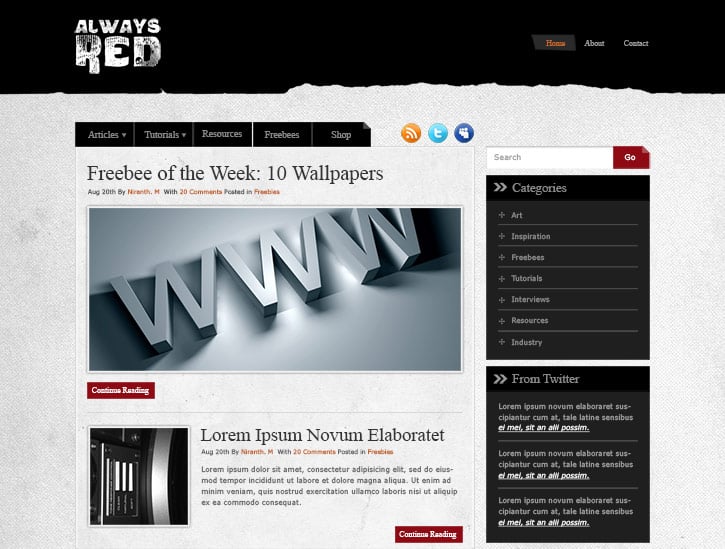Simplicity Redefined: A Comprehensive Guide to Crafting a Minimalist Blog Layout in Photoshop

Introduction:
In the ever-evolving landscape of web design, the minimalist approach has gained prominence for its clean, elegant, and user-friendly aesthetic. Creating a minimalist blog layout in Photoshop allows designers to focus on essential elements, providing a seamless and visually pleasing experience for readers. This comprehensive guide will take you through a step-by-step process, unraveling the techniques and principles needed to design a minimalist blog layout that not only captivates the audience but also embodies the essence of simplicity and sophistication.
Chapter 1: Embracing Minimalism in Web Design
1.1 Defining Minimalist Design:
- Explore the fundamental principles of minimalist design, emphasizing simplicity, clarity, and the elimination of unnecessary elements. Discuss how minimalist layouts create a sense of focus, allowing users to engage with content without distractions.
1.2 The Power of Negative Space:
- Discuss the importance of negative space, also known as white space, in minimalist design. Explore how judicious use of space enhances readability, draws attention to key elements, and contributes to an overall sense of elegance.
Chapter 2: Planning Your Minimalist Blog Layout
2.1 Understanding User Experience:
- Discuss the significance of user experience in blog design. Explore how a minimalist layout can enhance navigation, reduce cognitive load, and create an enjoyable reading experience for visitors.
2.2 Choosing a Simple Color Palette:
- Guide readers in selecting a simple and harmonious color palette for the blog layout. Discuss the psychological impact of colors and how a limited color scheme contributes to the minimalist aesthetic.
Chapter 3: Setting Up Your Photoshop Workspace
3.1 Creating a New Document:
- Provide step-by-step instructions on setting up a new document in Adobe Photoshop for the blog layout. Discuss considerations such as canvas size, resolution, and color mode to ensure a high-quality design.
3.2 Establishing a Grid System:
- Explore the use of a grid system to organize the layout elements. Discuss the benefits of a grid in achieving alignment, consistency, and a structured design that aligns with minimalist principles.
Chapter 4: Designing the Header and Navigation
4.1 Simplified Logo and Branding:
- Guide readers in creating a minimalist logo and incorporating branding elements. Discuss the use of clean typography, simple icons, and reduced complexity to achieve a cohesive and sophisticated brand representation.
4.2 Intuitive Navigation Bar:
- Discuss techniques for designing an intuitive and minimalist navigation bar. Explore options such as a simplified menu structure, dropdowns, or a hamburger menu, ensuring ease of navigation without clutter.
Chapter 5: Crafting Minimalist Typography
5.1 Choosing Clean Fonts:
- Explore the selection of clean and legible fonts for the blog’s typography. Discuss the importance of readability and how minimalist fonts contribute to a refined and modern appearance.
5.2 Hierarchy and Consistency:
- Guide readers in establishing typographic hierarchy and consistency throughout the blog layout. Discuss the strategic use of font sizes, weights, and styles to guide the reader’s eye through the content.
Chapter 6: Creating Minimalist Blog Posts
6.1 Streamlined Post Layout:
- Discuss the structure of minimalist blog posts, focusing on simplicity and clarity. Explore options for a clean post header, clear body text, and unobtrusive elements that enhance the reading experience.
6.2 Image Integration:
- Guide readers on integrating images into blog posts while maintaining a minimalist aesthetic. Discuss techniques for using high-quality visuals that complement the content without overwhelming the design.
Chapter 7: Implementing Minimalist Widgets and Sidebars
7.1 Selecting Essential Widgets:
- Discuss the concept of essential widgets and their role in a minimalist blog layout. Explore options such as search bars, categories, and recent posts, ensuring their integration enhances rather than disrupts the overall design.
7.2 Organizing Sidebars:
- Guide readers in organizing sidebars with a minimalist approach. Discuss the strategic placement of widgets, the use of negative space, and the elimination of unnecessary elements to maintain a clean and uncluttered look.
Chapter 8: Navigating the Footer with Simplicity
8.1 Incorporating Essential Footer Elements:
- Discuss the inclusion of essential elements in the footer, such as copyright information, social media links, and a brief about section. Explore ways to maintain simplicity while providing valuable information.
8.2 Responsive Design for Mobile:
- Guide readers on ensuring a minimalist blog layout is responsive for mobile devices. Discuss considerations such as font size, navigation adjustments, and image optimization to provide a seamless experience across different screen sizes.
Chapter 9: Balancing Minimalism with Visual Interest
9.1 Subtle Background Elements:
- Explore the incorporation of subtle background elements that add visual interest without compromising the minimalist aesthetic. Discuss techniques such as textures, gradients, or muted patterns that enhance the overall design.
9.2 Delicate Animations and Transitions:
- Discuss the strategic use of delicate animations and transitions to add a touch of interactivity. Explore how subtle movements can guide the user’s attention and contribute to a modern and engaging user experience.
Chapter 10: Reviewing and Refining the Minimalist Blog Layout
10.1 Comprehensive Design Review: – Encourage designers to conduct a comprehensive review of the minimalist blog layout. Discuss the importance of checking for consistency, alignment, and overall visual harmony before finalizing the design.
10.2 Gathering Feedback: – Guide readers on gathering feedback from peers or target users. Discuss the value of external perspectives in refining the design and ensuring it resonates with the intended audience.
Chapter 11: Exporting and Implementing the Minimalist Blog Layout
11.1 Exporting Assets for Web: – Provide instructions on exporting assets for the web. Discuss considerations for file formats, compression, and optimization to ensure quick loading times without compromising quality.
11.2 Implementing the Design on a Blog Platform: – Guide readers on implementing the minimalist blog layout on a chosen blogging platform. Discuss the steps for uploading images, adjusting settings, and ensuring a seamless transition from design to live website.
Chapter 12: Showcasing Your Minimalist Blog to the World
12.1 Design Presentations and Mockups: – Discuss the creation of design presentations and mockups to showcase the minimalist blog layout. Explore the use of digital mockups or application previews to present the blog in realistic contexts.
12.2 Promoting and Sharing: – Encourage designers to promote and share their minimalist blog on social media platforms and within design communities. Discuss strategies for gaining visibility, attracting readers, and fostering engagement.
Conclusion: Mastering the Art of Minimalist Blog Design
In conclusion, the journey of creating a minimalist blog layout in Photoshop is a masterful blend of art and functionality. This comprehensive guide has equipped you with the skills and knowledge to navigate the intricate process, ensuring your blog not only captivates with simplicity but also resonates with a modern and sophisticated audience. May your minimalist blog layout stand as a testament to the timeless allure of simplicity in web design. Happy designing!







